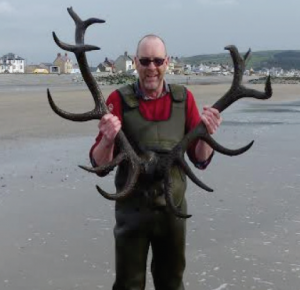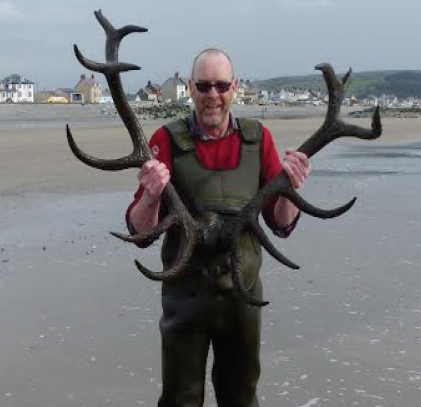
DR MARTIN BATES and a team of research staff from the School of Archaeology, History and Anthropology at the University of Wales Trinity Saint David (UWTSD) in Lampeter are currently examining a large red deer skull and antlers that are believed to be around 4000 years old.
The skull was first spotted on the beach at Borth, Ceredigion by Julien Culham and Sharon Davies-Culham in early April. Rather than attempting to remove the skull from the beach, they reported it to the Royal Commission in Aberystwyth who in turn alerted UWTSD’s Dr Martin Bates who has been working in Borth for many years.
“This is a wonderful discovery that really brings the forest and its environs to light,” says Dr Bates.
“The ‘unhelpful’ tides during the two weeks since the discovery meant that no progress could be made in recovering the find. Then last Friday, an attempt was made to relocate the skull, but even at low tide, the area of beach containing the find remained under 1m of water.
“Concerns about the possibility that bad weather may cause extensive movement of sand and gravel on the sea bed – resulting in either covering up the find or damaging it – meant that we decided to attempt to relocate the find beneath the water,” continues Dr Bates.
“This was only possible because the original site was photographed and an approximate position could be calculated from this information. The seabed was searched methodically by feel and touch until, remarkably, the skull was relocated. Its position was recorded and the find removed for cleaning and recording. Further investigation of the find spot will be made during the next set of low tides in early May,” continues Dr Bates.
The find comes from a large channel cut through the well-known fossil forest preserved at Borth.
Previously this channel yielded the bones of a large auroch, an extinct form of large wild cattle that once lived in Europe. This was discovered in the 1960’s but has subsequently been lost to academic study.
The forest and peat deposits either side of this channel date to between about 6000 and 4000 years ago – the time of the last hunter gatherers and the earliest farmers in Britain.
“Although the exact age of the skull has yet to be confirmed, it’s probable that the channel within which the find was made is contemporary with the forest, and so an age in excess of 4000 years old is likely,” adds Dr Bates.
“It is wonderful that this find was reported to us so that we could recover these remains for scientific study rather than it ending up on the wall in somebody’s house, lost to the world much as it has been for the last 4000 years,” he continues.
Dr Ros Coard, a faunal specialist at UWTSD Lampeter says: “Animal bones are known to erode out of their original deposits all along the coast of Wales, especially after the winter storms and are often reported by members of the public. None are as large or as impressive as this recent find however.
“Although the antlers and partial skull still have to undergo full analysis, the antlers can be said to come from a very large, mature male red deer. The individual was certainly in the prime of his life showing full development of the large antlers. They will undergo further analysis at UWTSD in Lampeter.”
The discovery is on part in an on-going series of investigations undertaken by staff at UWTSD into the forest and its environs. Construction activity of the new sea defences have provided new opportunities to study the forest and the work, funded by Ceredigion County Council, is being undertaken in Lampeter on samples recovered from this scheme.
This project should provide detailed reconstructions of the forest through its life and may shed light on how and why the forest died and the sea flooded the area once again.
Dr Bates has also recently won a grant from the Independent Social Research Foundation (ISRF) to combine a group of specialists from diverse fields (artist, storyteller, philologist, geoarcheologist, songwriter and poet) to create a new understanding regarding the interplay of flooding facts and fictions in Cardigan Bay.
This new find, returning from this flooded landscape, may now play a central role in this project.
In addition to his work in Borth, Dr Martin Bates is involved in exploring the lost landscapes of the Norfolk coastline and in 2013 discovered a series of footprints left by early humans in ancient estuary muds over 800,000 years ago at the Happisburgh site in Norfolk
The footprints, discovered in May 2013, were the oldest recorded footprints outside of Africa and are direct evidence of the earliest known humans in northern Europe. The footprint surface was exposed at low tide as heavy seas removed the beach sands to reveal a series of elongated hollows cut into compacted silts.
The surface was recorded using photogrammetry, a technique that can stitch together digital photographs to create a permanent record and 3D images of the surface. It was the analysis of these images that confirmed that the elongated hollows were indeed ancient human footprints.
















Add Comment